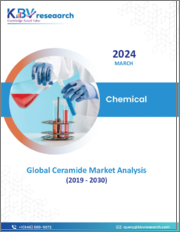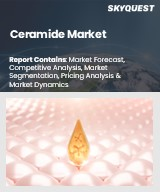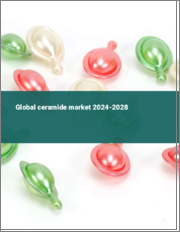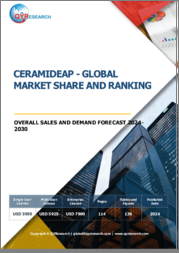
|
시장보고서
상품코드
1462007
세계의 세라마이드 시장 규모, 점유율 및 동향 분석 보고서 - 용도별, 공정별, 유형별, 지역별 전망 및 예측(2023-2030년)Global Ceramide Market Size, Share & Trends Analysis Report By Application (Cosmetics, Food, and Others), By Process (Plant Extract, and Fermentation), By Type (Natural, and Synthetic), By Regional Outlook and Forecast, 2023 - 2030 |
||||||
세라마이드 시장 규모는 예측 기간 동안 5.6%의 연평균 복합 성장률(CAGR)로 시장이 성장하여 2030년까지 1억 4,600만 달러에 달할 것으로 예상됩니다. 2022년에는 459.83톤 규모에 달했고, 2.6%의 성장률(2019-2022)을 나타냈습니다.
또한, 전 세계적으로 인구 고령화가 진행되면서 젊어 보이는 외모와 피부 건강을 유지하기 위한 피부 관리의 중요성에 대한 인식이 높아지고 있습니다. 캐나다 통계청에 따르면 2022년 캐나다의 65세 이상 인구는 7,330,605명입니다. 또한 2021년 인구 조사에서 85세 이상 인구는 861,000명 이상으로 집계되었으며, 이는 2001년 인구 조사에서 관찰된 숫자의 두 배 이상입니다. 마찬가지로, 2022년 범미보건기구가 제공한 자료에 따르면 브라질에는 3,000만 명 이상이 60세 이상이며, 이는 전체 인구의 13%를 차지합니다.
그러나 많은 소비자들은 '세라마이드'라는 용어와 스킨케어에서 세라마이드의 중요성에 대해 잘 알지 못할 수도 있습니다. 제품 개발자는 세라마이드에 대한 소비자의 니즈와 선호도를 명확하게 이해하지 못하면 타겟층의 공감을 얻을 수 있는 효과적인 포뮬러를 만드는 데 어려움을 겪을 수 있습니다. 따라서 이러한 요인으로 인해 시장에서 수요는 감소할 수 있습니다.
목차
제1장 시장 범위와 조사 방법
- 시장의 정의
- 목적
- 시장 범위
- 세분화
- 조사 방법
제2장 시장 요람
- 주요 하이라이트
제3장 시장 개요
- 서론
- 개요
- 시장 구성과 시나리오
- 개요
- 시장에 영향을 미치는 주요 요인
- 시장 성장 촉진요인
- 시장 기회
- 시장 성장 억제요인
- 시장이 해결해야 할 과제
- Porter의 Five Forces 분석
제4장 세라마이드 시장에서 전개되는 전략
제5장 세계 시장 : 용도별
- 세계의 화장품 시장 : 지역별
- 세계의 식품 시장 : 지역별
- 세계의 기타 시장 : 지역별
제6장 세계 시장 : 프로세스별
- 세계의 식물 추출물 시장 : 지역별
- 세계의 발효 시장 : 지역별
제7장 세계 시장 : 유형별
- 세계의 천연 시장 : 지역별
- 세계의 합성 시장 : 지역별
제8장 세계 시장 : 지역별
- 북미 시장
- 북미 시장 : 용도별
- 국가별 북미 화장품 시장
- 국가별 북미 식품 시장
- 국가별 북미 기타 시장
- 북미 시장 : 프로세스별
- 국가별 북미 식물 추출물 시장
- 국가별 북미 발효 시장
- 북미 시장 : 유형별
- 국가별 북미 천연자원 시장
- 국가별 북미 합성 시장
- 북미 시장 : 국가별
- 미국 세라마이드 시장
- 캐나다 세라마이드 시장
- 멕시코 세라마이드 시장
- 기타 북미 시장
- 북미 시장 : 용도별
- 유럽 시장
- 유럽 시장 : 용도별
- 국가별 유럽 화장품 시장
- 국가별 유럽 식품 시장
- 유럽 기타 국가별 시장
- 유럽 시장 : 프로세스별
- 국가별 유럽 식물 추출물 시장
- 국가별 유럽 발효 시장
- 유럽 시장 : 유형별
- 국가별 유럽 천연 시장
- 국가별 유럽 합성 시장
- 유럽 시장 : 국가별
- 독일 세라마이드 시장
- 영국 세라마이드 시장
- 프랑스 세라마이드 시장
- 러시아 세라마이드 시장
- 스페인 세라마이드 시장
- 이탈리아 세라마이드 시장
- 기타 유럽 시장
- 유럽 시장 : 용도별
- 아시아태평양 시장
- 아시아태평양 시장 : 용도별
- 아시아태평양 국가별 화장품 시장
- 아시아태평양 국가별 식품 시장
- 아시아태평양 기타 시장 :(국가별)
- 아시아태평양 시장 : 프로세스별
- 아시아태평양 국가별 식물 추출물 시장
- 아시아태평양 국가별 발효 시장
- 아시아태평양 시장 : 유형별
- 아시아태평양 국가별 천연자원 시장
- 아시아태평양 국가별 합성 시장
- 아시아태평양 시장 : 국가별
- 중국 세라마이드 시장
- 일본 세라마이드 시장
- 인도 세라마이드 시장
- 한국 세라마이드 시장
- 싱가포르 세라마이드 시장
- 말레이시아 세라마이드 시장
- 기타 아시아태평양 시장
- 아시아태평양 시장 : 용도별
- 라틴아메리카/중동 및 아프리카 시장
- 라틴아메리카/중동 및 아프리카 시장 : 용도별
- 라틴아메리카/중동 및 아프리카 국가별 화장품 시장
- 국가별 라틴아메리카/중동 및 아프리카 식품 시장
- 라틴아메리카/중동 및 아프리카 기타 시장 :(국가별)
- 라틴아메리카/중동 및 아프리카 시장 : 프로세스별
- 국가별 라틴아메리카/중동 및 아프리카 식물 추출물 시장
- 국가별 라틴아메리카/중동 및 아프리카 발효 시장
- 라틴아메리카/중동 및 아프리카 시장 : 유형별
- 국가별 라틴아메리카/중동 및 아프리카 내츄럴 마켓
- 국가별 라틴아메리카/중동 및 아프리카 합성 시장
- 라틴아메리카/중동 및 아프리카 시장 : 국가별
- 브라질 세라마이드 시장
- 아르헨티나 세라마이드 시장
- 아랍에미리트(UAE) 세라마이드 시장
- 사우디아라비아 세라마이드 시장
- 남아프리카공화국 세라마이드 시장
- 나이지리아 세라마이드 시장
- 기타 라틴아메리카/중동 및 아프리카 시장
- 라틴아메리카/중동 및 아프리카 시장 : 용도별
제9장 기업 개요
- Ashland Inc
- Toyobo Co, Ltd.
- Doosan Corporation
- Arkema SA
- Evonik Industries AG(RAG-Stiftung)
- Cayman Chemical Company, Inc
- Kao Corporation
- Croda International PLC
- Vantage Specialty Chemicals(HI.G. Capital, LLC)
- Incospam Co, Ltd.
제10장 세라마이드 시장을 위한 성공 필수 조건
LSH 24.04.24The Global Ceramide Market size is expected to reach $146.0 million by 2030, rising at a market growth of 5.6% CAGR during the forecast period. In the year 2022, the market attained a volume of 459.83 tonnes, experiencing a growth of 2.6% (2019-2022).
Rapid urbanization and changing lifestyles in countries across the Asia Pacific have led to increased exposure to environmental stressors such as pollution, UV radiation, and air conditioning. Therefore, the Asia Pacific segment captured $35,246.9 thousands in the market in 2022. Also, the Japan segment make use of 31.20 tonnes of Ceramide in 2022. As a result, consumers are turning to skincare products containing it to combat dryness, irritation, and premature aging caused by these external factors. Hence, these aspects can boost the demand in the segment.
Continuous technological progress has resulted in the creation of enhanced techniques for extracting it from organic sources, including animals and vegetation. With improved production efficiency and cost-effectiveness, It find applications beyond the skincare and haircare industries. They are increasingly used in various sectors, such as pharmaceuticals, nutraceuticals, and industrial applications. Thus, owing to these factors, the market will grow rapidly in the coming years.
Additionally, with the global population aging, there's a growing awareness about the importance of skincare for maintaining youthful appearance and skin health. As per Statistics Canada, in 2022, there were 7,330,605 people aged 65 and older in Canada. Moreover, over 861,000 people aged 85 and older were counted in the 2021 Census, more than twice the number observed in the 2001 Census. Likewise, as per the data provided in 2022 by the Pan American Health Organization, more than 30 million individuals in Brazil were 60 years of age or elderly, accounting for 13 percent of the country's total population.
However, many consumers may not be familiar with the term "ceramide" or its significance in skincare. Product developers may struggle to create effective formulations that resonate with target audiences without a clear understanding of consumer needs and preferences regarding ceramides. Hence, owing to these factors, there will be reduced demand in the market.
By Application Analysis
Based on application, the market is divided into cosmetics, food, and others. The cosmetics segment recorded the maximum revenue share in the market in 2022. In terms of volume, cosmetics segment would make use of 430.97 tonnes of ceramide in cosmetics by 2030. Consumers are increasingly seeking natural and botanical ingredients in their skincare products. It derived from natural sources, such as plant extracts or its oils, appeal to consumers looking for effective yet gentle skincare solutions, driving the demand for ceramide-containing cosmetics.
By Process Analysis
On the basis of process, the market is divided into fermentation and plant extract. The fermentation segment recorded a considerable revenue share in the market in 2022. Advances in biotechnology have enabled the production of ceramides through fermentation processes using microorganisms. This method offers a more sustainable and cost-effective way to produce it compared to traditional extraction methods from animal or plant sources.
By Type Analysis
Based on type, the market is bifurcated into natural and synthetic. The natural segment held the 66.65% revenue share in the market in 2022. In terms of volume, natural segment would utilize 455.72 tonnes of natural ceramide by 2030. There is a growing consumer preference for natural and organic products across various industries, including skincare and cosmetics. This demand extends to ingredients used in these products, leading to an increased interest in natural ceramides derived from plant sources. Ceramides, especially those sourced naturally, are recognized for their role in maintaining the skin barrier and hydration, making them appealing ingredients in skincare and beauty products.
By Regional Analysis
By region, the market is segmented into North America, Europe, Asia Pacific, and LAMEA. In 2022, the Europe segment acquired a 29.22% revenue share in the market. In terms of volume, Europe segment would register 188.46 tonnes of ceramide by 2030. European consumers are increasingly seeking out natural and organic skincare products. It especially those derived from natural sources like plant extracts, align well with this trend. Products marketed as containing natural ceramides may attract consumers looking for safer, eco-friendly alternatives.
Market Competition and Attributes
The market exhibits competitive dynamics driven by key players such as Evonik Industries, Croda International PLC, Ashland Inc., and Doosan Corporation, among others. Competition is fueled by factors including research and development for innovative product formulations, expansion into new application areas such as skincare and pharmaceuticals, strategic partnerships, and efforts to maintain product quality and regulatory compliance. As consumer awareness of its benefits grows, companies vie for market share through differentiation strategies and market penetration, shaping a dynamic competitive landscape within the industry.
Recent Strategies Deployed in the Market
- Mar-2024: Evonik Industries AG unveiled its latest sustainable portfolio and powerful technology platforms for skin and hair care, as well as household cleaning and air care. Through this launch, the company is looking forward to further collaborating with our local customers to drive the industry's green transformation.
- Feb-2024: Kao Corporation is unveiling Curel Outfit-for-Skin Potion and Curel Veil Creator to tackle severe skin dryness. These product uses ceramides and Kao's "Fine Fiber Technology" to create an "ultra-thin, moisture-rich" veil that immediately covers the skin and penetrates deep into the stratum corneum, designed for relief and long-lasting hydration. Through this launch company is expanding its product portfolio.
- Jul-2023: Croda International PLC acquired Solus Biotech, a global leader in biotechnology-derived active ingredients for beauty care and pharmaceuticals, to supply sustainable, natural actives for personal care across three critical technology platforms: peptides, ceramides, and retinol. Through his acquisition, the company will enhance its sustainable biotechnology capabilities and add innovation facilities, providing a springboard to premium markets in Asia and beyond.
- Nov-2022: Evonik Industries AG has geographically expanded its footprints in Heidelberg, Germany, by manufacturing commercial quantities of ceramides, a special class of lipids. Through this expansion, the company is aiming to build its Nutrition & Care segment portfolio.
List of Key Companies Profiled
- Ashland Inc.
- Toyobo Co., Ltd.
- Doosan Corporation
- Arkema S.A.
- Evonik Industries AG (RAG-Stiftung)
- Cayman Chemical Company, Inc.
- Kao Corporation
- Croda International PLC
- Vantage Specialty Chemicals (H.I.G. Capital, LLC)
- Incospam Co., Ltd.
Global Ceramide Market Report Segmentation
By Application (Volume, Tonnes, USD Million, 2019-2030)
- Cosmetics
- Food
- Others
By Process
- Plant Extract
- Fermentation
By Type (Volume, Tonnes, USD Million, 2019-2030)
- Natural
- Synthetic
By Geography (Volume, Tonnes, USD Million, 2019-2030)
- North America
- US
- Canada
- Mexico
- Rest of North America
- Europe
- Germany
- UK
- France
- Russia
- Spain
- Italy
- Rest of Europe
- Asia Pacific
- China
- Japan
- India
- South Korea
- Singapore
- Malaysia
- Rest of Asia Pacific
- LAMEA
- Brazil
- Argentina
- UAE
- Saudi Arabia
- South Africa
- Nigeria
- Rest of LAMEA
Table of Contents
Chapter 1.Market Scope & Methodology
- 1.1Market Definition
- 1.2Objectives
- 1.3Market Scope
- 1.4Segmentation
- 1.4.1Global Ceramide Market, by Application
- 1.4.2Global Ceramide Market, by Process
- 1.4.3Global Ceramide Market, by Type
- 1.4.4Global Ceramide Market, by Geography
- 1.5Methodology for the research
Chapter 2.Market at a Glance
- 2.1Key Highlights
Chapter 3.Market Overview
- 3.1Introduction
- 3.1.1Overview
- 3.1.1.1Market Composition and Scenario
- 3.1.1Overview
- 3.2Key Factors Impacting the Market
- 3.2.1Market Drivers
- 3.2.2Market Opportunities
- 3.2.3Market Restraints
- 3.2.4Market Challenges
- 3.3Porter's Five Forces Analysis
Chapter 4.Strategies Deployed in Ceramide Market
Chapter 5.Global Ceramide Market, By Application
- 5.1Global Cosmetics Market, By Region
- 5.2Global Food Market, By Region
- 5.3Global Others Market, By Region
Chapter 6.Global Ceramide Market, By Process
- 6.1Global Plant Extract Market, By Region
- 6.2Global Fermentation Market, By Region
Chapter 7.Global Ceramide Market, By Type
- 7.1Global Natural Market, By Region
- 7.2Global Synthetic Market, By Region
Chapter 8.Global Ceramide Market, By Region
- 8.1North America Ceramide Market
- 8.1.1North America Ceramide Market, By Application
- 8.1.1.1North America Cosmetics Market, By Country
- 8.1.1.2North America Food Market, By Country
- 8.1.1.3North America Others Market, By Country
- 8.1.2North America Ceramide Market, By Process
- 8.1.2.1North America Plant Extract Market, By Country
- 8.1.2.2North America Fermentation Market, By Country
- 8.1.3North America Ceramide Market, By Type
- 8.1.3.1North America Natural Market, By Country
- 8.1.3.2North America Synthetic Market, By Country
- 8.1.4North America Ceramide Market, By Country
- 8.1.4.1US Ceramide Market
- 8.1.4.1.1US Ceramide Market, By Application
- 8.1.4.1.2US Ceramide Market, By Process
- 8.1.4.1.3US Ceramide Market, By Type
- 8.1.4.2Canada Ceramide Market
- 8.1.4.2.1Canada Ceramide Market, By Application
- 8.1.4.2.2Canada Ceramide Market, By Process
- 8.1.4.2.3Canada Ceramide Market, By Type
- 8.1.4.3Mexico Ceramide Market
- 8.1.4.3.1Mexico Ceramide Market, By Application
- 8.1.4.3.2Mexico Ceramide Market, By Process
- 8.1.4.3.3Mexico Ceramide Market, By Type
- 8.1.4.4Rest of North America Ceramide Market
- 8.1.4.4.1Rest of North America Ceramide Market, By Application
- 8.1.4.4.2Rest of North America Ceramide Market, By Process
- 8.1.4.4.3Rest of North America Ceramide Market, By Type
- 8.1.4.1US Ceramide Market
- 8.1.1North America Ceramide Market, By Application
- 8.2Europe Ceramide Market
- 8.2.1Europe Ceramide Market, By Application
- 8.2.1.1Europe Cosmetics Market, By Country
- 8.2.1.2Europe Food Market, By Country
- 8.2.1.3Europe Others Market, By Country
- 8.2.2Europe Ceramide Market, By Process
- 8.2.2.1Europe Plant Extract Market, By Country
- 8.2.2.2Europe Fermentation Market, By Country
- 8.2.3Europe Ceramide Market, By Type
- 8.2.3.1Europe Natural Market, By Country
- 8.2.3.2Europe Synthetic Market, By Country
- 8.2.4Europe Ceramide Market, By Country
- 8.2.4.1Germany Ceramide Market
- 8.2.4.1.1Germany Ceramide Market, By Application
- 8.2.4.1.2Germany Ceramide Market, By Process
- 8.2.4.1.3Germany Ceramide Market, By Type
- 8.2.4.2UK Ceramide Market
- 8.2.4.2.1UK Ceramide Market, By Application
- 8.2.4.2.2UK Ceramide Market, By Process
- 8.2.4.2.3UK Ceramide Market, By Type
- 8.2.4.3France Ceramide Market
- 8.2.4.3.1France Ceramide Market, By Application
- 8.2.4.3.2France Ceramide Market, By Process
- 8.2.4.3.3France Ceramide Market, By Type
- 8.2.4.4Russia Ceramide Market
- 8.2.4.4.1Russia Ceramide Market, By Application
- 8.2.4.4.2Russia Ceramide Market, By Process
- 8.2.4.4.3Russia Ceramide Market, By Type
- 8.2.4.5Spain Ceramide Market
- 8.2.4.5.1Spain Ceramide Market, By Application
- 8.2.4.5.2Spain Ceramide Market, By Process
- 8.2.4.5.3Spain Ceramide Market, By Type
- 8.2.4.6Italy Ceramide Market
- 8.2.4.6.1Italy Ceramide Market, By Application
- 8.2.4.6.2Italy Ceramide Market, By Process
- 8.2.4.6.3Italy Ceramide Market, By Type
- 8.2.4.7Rest of Europe Ceramide Market
- 8.2.4.7.1Rest of Europe Ceramide Market, By Application
- 8.2.4.7.2Rest of Europe Ceramide Market, By Process
- 8.2.4.7.3Rest of Europe Ceramide Market, By Type
- 8.2.4.1Germany Ceramide Market
- 8.2.1Europe Ceramide Market, By Application
- 8.3Asia Pacific Ceramide Market
- 8.3.1Asia Pacific Ceramide Market, By Application
- 8.3.1.1Asia Pacific Cosmetics Market, By Country
- 8.3.1.2Asia Pacific Food Market, By Country
- 8.3.1.3Asia Pacific Others Market, By Country
- 8.3.2Asia Pacific Ceramide Market, By Process
- 8.3.2.1Asia Pacific Plant Extract Market, By Country
- 8.3.2.2Asia Pacific Fermentation Market, By Country
- 8.3.3Asia Pacific Ceramide Market, By Type
- 8.3.3.1Asia Pacific Natural Market, By Country
- 8.3.3.2Asia Pacific Synthetic Market, By Country
- 8.3.4Asia Pacific Ceramide Market, By Country
- 8.3.4.1China Ceramide Market
- 8.3.4.1.1China Ceramide Market, By Application
- 8.3.4.1.2China Ceramide Market, By Process
- 8.3.4.1.3China Ceramide Market, By Type
- 8.3.4.2Japan Ceramide Market
- 8.3.4.2.1Japan Ceramide Market, By Application
- 8.3.4.2.2Japan Ceramide Market, By Process
- 8.3.4.2.3Japan Ceramide Market, By Type
- 8.3.4.3India Ceramide Market
- 8.3.4.3.1India Ceramide Market, By Application
- 8.3.4.3.2India Ceramide Market, By Process
- 8.3.4.3.3India Ceramide Market, By Type
- 8.3.4.4South Korea Ceramide Market
- 8.3.4.4.1South Korea Ceramide Market, By Application
- 8.3.4.4.2South Korea Ceramide Market, By Process
- 8.3.4.4.3South Korea Ceramide Market, By Type
- 8.3.4.5Singapore Ceramide Market
- 8.3.4.5.1Singapore Ceramide Market, By Application
- 8.3.4.5.2Singapore Ceramide Market, By Process
- 8.3.4.5.3Singapore Ceramide Market, By Type
- 8.3.4.6Malaysia Ceramide Market
- 8.3.4.6.1Malaysia Ceramide Market, By Application
- 8.3.4.6.2Malaysia Ceramide Market, By Process
- 8.3.4.6.3Malaysia Ceramide Market, By Type
- 8.3.4.7Rest of Asia Pacific Ceramide Market
- 8.3.4.7.1Rest of Asia Pacific Ceramide Market, By Application
- 8.3.4.7.2Rest of Asia Pacific Ceramide Market, By Process
- 8.3.4.7.3Rest of Asia Pacific Ceramide Market, By Type
- 8.3.4.1China Ceramide Market
- 8.3.1Asia Pacific Ceramide Market, By Application
- 8.4LAMEA Ceramide Market
- 8.4.1LAMEA Ceramide Market, By Application
- 8.4.1.1LAMEA Cosmetics Market, By Country
- 8.4.1.2LAMEA Food Market, By Country
- 8.4.1.3LAMEA Others Market, By Country
- 8.4.2LAMEA Ceramide Market, By Process
- 8.4.2.1LAMEA Plant Extract Market, By Country
- 8.4.2.2LAMEA Fermentation Market, By Country
- 8.4.3LAMEA Ceramide Market, By Type
- 8.4.3.1LAMEA Natural Market, By Country
- 8.4.3.2LAMEA Synthetic Market, By Country
- 8.4.4LAMEA Ceramide Market, By Country
- 8.4.4.1Brazil Ceramide Market
- 8.4.4.1.1Brazil Ceramide Market, By Application
- 8.4.4.1.2Brazil Ceramide Market, By Process
- 8.4.4.1.3Brazil Ceramide Market, By Type
- 8.4.4.2Argentina Ceramide Market
- 8.4.4.2.1Argentina Ceramide Market, By Application
- 8.4.4.2.2Argentina Ceramide Market, By Process
- 8.4.4.2.3Argentina Ceramide Market, By Type
- 8.4.4.3UAE Ceramide Market
- 8.4.4.3.1UAE Ceramide Market, By Application
- 8.4.4.3.2UAE Ceramide Market, By Process
- 8.4.4.3.3UAE Ceramide Market, By Type
- 8.4.4.4Saudi Arabia Ceramide Market
- 8.4.4.4.1Saudi Arabia Ceramide Market, By Application
- 8.4.4.4.2Saudi Arabia Ceramide Market, By Process
- 8.4.4.4.3Saudi Arabia Ceramide Market, By Type
- 8.4.4.5South Africa Ceramide Market
- 8.4.4.5.1South Africa Ceramide Market, By Application
- 8.4.4.5.2South Africa Ceramide Market, By Process
- 8.4.4.5.3South Africa Ceramide Market, By Type
- 8.4.4.6Nigeria Ceramide Market
- 8.4.4.6.1Nigeria Ceramide Market, By Application
- 8.4.4.6.2Nigeria Ceramide Market, By Process
- 8.4.4.6.3Nigeria Ceramide Market, By Type
- 8.4.4.7Rest of LAMEA Ceramide Market
- 8.4.4.7.1Rest of LAMEA Ceramide Market, By Application
- 8.4.4.7.2Rest of LAMEA Ceramide Market, By Process
- 8.4.4.7.3Rest of LAMEA Ceramide Market, By Type
- 8.4.4.1Brazil Ceramide Market
- 8.4.1LAMEA Ceramide Market, By Application
Chapter 9.Company Profiles
- 9.1Ashland Inc.
- 9.1.1Company Overview
- 9.1.2Financial Analysis
- 9.1.3Segmental and Regional Analysis
- 9.1.4Research & Development Expenses
- 9.1.5SWOT Analysis
- 9.2Toyobo Co., Ltd.
- 9.2.1Company Overview
- 9.2.2Financial Analysis
- 9.2.3Segmental and Regional Analysis
- 9.2.4SWOT Analysis
- 9.3Doosan Corporation
- 9.3.1Company Overview
- 9.3.2Financial Analysis
- 9.3.3Segmental and Regional Analysis
- 9.3.4Research & Development Expenses
- 9.3.5SWOT Analysis
- 9.4Arkema S.A.
- 9.4.1Company Overview
- 9.4.2Financial Analysis
- 9.4.3Segmental and Regional Analysis
- 9.4.4Research & Development Expenses
- 9.4.5Recent strategies and developments:
- 9.4.5.1Acquisition and Mergers:
- 9.4.6SWOT Analysis
- 9.5Evonik Industries AG (RAG-Stiftung)
- 9.5.1Company Overview
- 9.5.2Financial Analysis
- 9.5.3Segmental and Regional Analysis
- 9.5.4Research & Development Expenses
- 9.5.5Recent strategies and developments:
- 9.5.5.1Product Launches and Product Expansions:
- 9.5.5.2Geographical Expansions:
- 9.5.6SWOT Analysis
- 9.6Cayman Chemical Company, Inc.
- 9.6.1Company Overview
- 9.6.2SWOT Analysis
- 9.7Kao Corporation
- 9.7.1Company Overview
- 9.7.2Financial Analysis
- 9.7.3Segmental and Regional Analysis
- 9.7.4Research & Development Expenses
- 9.7.5Recent strategies and developments:
- 9.7.5.1Product Launches and Product Expansions:
- 9.7.6SWOT Analysis
- 9.8Croda International PLC
- 9.8.1Company Overview
- 9.8.2Financial Analysis
- 9.8.3Segmental and Regional Analysis
- 9.8.4Recent strategies and developments:
- 9.8.4.1Acquisition and Mergers:
- 9.8.5SWOT Analysis
- 9.9Vantage Specialty Chemicals (H.I.G. Capital, LLC)
- 9.9.1Company Overview
- 9.9.2Recent strategies and developments:
- 9.9.2.1Partnerships, Collaborations, and Agreements:
- 9.9.2.2Geographical Expansions:
- 9.9.3SWOT Analysis
- 9.10.Incospam Co., Ltd.
- 9.10.1Company Overview
- 9.10.2SWOT Analysis

















